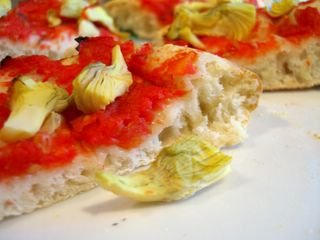Perfect Pizza Crust
Normally, I don't cross-post things to both this site and Slashfood, but this pizza crust warrants an exception.
This crust is a recipe from the most recent issue of Cook's Illustrated. It caught my eye because there was a tagline that said "great pizza without an 800-degree oven." I guess it doesn't take much to convince me.
I've made good pizzas at home, but never a great pizza until now. The crust was incredibly easy to put together and baked up light, crispy and full of air pockets, which I love to see in my crusts. The dough was actually made in the food processor, so it took very little effort in terms of mixing and kneading, and it was also very easy to handle.
The secret to the crust is the use of cake flour. In a commercial pizza oven, the dough cooks so quickly that a high protein flour (like bread flour) is needed to maintain the chewiness of the crust and keep the pizza from drying out. In a home oven, the pizza spends more time cooking because it is done at a lower temperature; the high-protein flour doughs take too long to cook, resulting in a tough pizzza, while the dough made with the low-protein cake flour cooked faster and delivered a crust with a tender interior and crisp crust.
View a photo essay of the pizza-making process here.
The other key to this recipe is a pizza stone. Pizza stones absorb the heat of the oven and cook the dough from the bottom as well as from the top, producing a crisper, lighter crust. It is imperative that you use a pizza stone to get the best results. I got mine for about $10 at Trader Joe's. You don't need an expensive one, any one will do.
Perfect Pizza Crust
(from Cooks Illustrated)
1 1/4 tsp instant or active dry yeast
1 cup water, slightly warm or room temperature
1 3/4 cups (8 3/4 oz) all-purpose flour, plus more for work surface
1 cup (4 oz) cake flour
1 1/2 tsp salt
2 tsp sugar
Preheat the oven to 500F with your baking stone on the oven rack.
Combine yeast and water and stir to dissolve.
Combine flours, salt and sugar in the bowl of a food processor and pulse to blend. With the motor running, stream in water/yeast mixture. Continue to process for 1-2 minutes, until dough becomes smooth and satiny. Add an extra tablespoon of flour if the dough becomes too sticky (see photos).
Divide dough into two and shape each piece into a tight ball. Place on a lightly floured surface and cover with lightly oiled plastic wrap or a clean dish towel. Let rise for 1 hour, or until doubled in size.
Working with one ball of dough at a time, place on a lightly floured surface. Flatten the dough into an 8-inch disk, then stretch the edges gently until the dough is about 12-inches in diameter, rotating the dough by quarter turns as you work. You can also gently stretch the dough by placing it on the backs of your hands, letting the weight of the dough stretch it out.
Transfer the stretched dough onto a baking sheet that has been covered with cornmeal (you can use a pizza peel, if you have one). Spread it with a small amount of the sauce (see recipe below), toppings of your choice and slide it quickly into the oven.
Bake pizza at 500F for 5-10 minutes, until well browned.
Retrieve pizza with baking sheet or pizza peel.
Serve immediately and repeat process with second piece of dough.
Makes 2, 12-inch pizzas
Note: You can also use the "convection bake" setting, if your oven has one, and reduce the cooking time by 1-2 minutes. This allows for extra air circulation and could result in a slightly crisper crust, as well as a quicker cooking time.
Pizza Margherita Sauce
Cooks Illustrated offered a really simple sauce with the crust recipe. It's made from canned tomatoes, so take care to use good ones. I've had better sauces, but I've also had worse. For a simple recipe, this one isn't bad.
2 15-oz cans whole plum tomatoes (or diced tomatoes)
1/2 tsp sugar
1 clove garlic (optional - I left it out), minced
1/4 cup fresh basil, chopped
salt, to taste
Whizz tomatoes and the rest of the ingredients in a food processor until tomatoes are broken up. Drain with a fine mesh strainer for at least 30 minutes to get rid of excess moisture that could make the dough soggy.
Toppings
Cooks Illustrated recommends using fresh mozzarella, cut into 1/4-1/2 inch pieces or a simple sprinkle of parmesan if you're not a big cheese eater. The crust is also excellent with just the toppings and sauce, if you don't want any cheese. Other options include:
Diced artichoke hearts (pictured above) are delicious, as are other veggies
Thinnly sliced red onion goes with just about everything
Pepperoni or thinnly sliced ham/sausage is always an option for meat eaters
The crust is light, so very "wet" ingredients, like fresh tomatoes, may not be a good choice.


<< Home